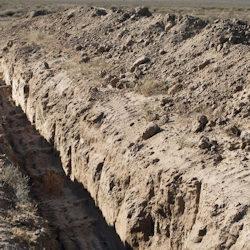Fall Protection
Employers must ensure that any worker who enters a bell- bottom pier hole or similar deep and confined footing excavation wears a harness with a lifeline. The lifeline must be attached securely to the harness and must be separate from any line used to handle materials. Also, the lifeline must be individually attended by an observer at all times when the worker wearing the lifeline is in the excavation.
Falling Loads and Moving Equipment
In addition to cave-ins and related hazards, workers involved in excavation work are exposed to hazards involving falling loads and mobile equipment. To protect workers from these hazards, OSHA requires employers to take certain precautions.
For example, employers must:
- Place spoils, stored materials, and equipment at least 2 feet (0.61 meters) from the edge and/or by using a retaining device to keep the materials or equipment from falling or rolling into the excavation.
- Provide a warning system (such as barricades, spotters using hand or mechanical signals.
- Use stop blocks when mobile equipment must approach the edge of an excavation and the operator does not have a clear and direct view of the edge.
- Protect workers from loose rock or soil that could fall or roll from an excavation face by scaling to remove loose material, installing protective barricades at appropriate intervals, or using other equivalent forms of protection.
- Institute and enforce work rules prohibiting workers from working on faces of sloped or benched excavations at levels above other workers unless the workers at the lower levels are adequately protected from the hazards of falling, rolling, or sliding material or equipment.
- Institute and enforce work rules prohibiting workers from standing or working under loads being handled by lifting or digging equipment.
- Require workers to stand away from vehicles being loaded or unloaded to protect them from being struck by any spillage or falling materials. (Operators may remain inside the cab of a vehicle being loaded or unloaded if the vehicle is equipped, in accord with 29 CFR 1926.601(b)(6), to provide adequate protection for the operator.)
(1) General.
- (i) Members of support systems shall be securely connected together to prevent sliding, falling, kickouts, or other predictable failure.
- (ii) Support systems shall be installed and removed in a manner that protects employees from cave-ins, structural collapses, or from being struck by members of the support system.
- (iii) Individual members of support systems shall not be subjected to loads exceeding those which those members were designed to withstand.
- (iv) Before temporary removal of individual members begins, additional precautions shall be taken to ensure the safety of employees, such as installing other structural members to carry the loads imposed on the support system.
- (v) Removal shall begin at, and progress from, the bottom of the excavation. Members shall be released slowly so as to note any indication of possible failure of the remaining members of the structure or possible cave-in of the sides of the excavation.
- (vi) Backfilling shall progress together with the removal of support systems from excavations.
1926.652(e)(2) Additional requirements for support systems for trench excavations.
- (i) Excavation of material to a level no greater than 2 feet (.61 m) below the bottom of the members of a support system shall be permitted, but only if the system is designed to resist the forces calculated for the full depth of the trench, and there are no indications while the trench is open of a possible loss of soil from behind or below the bottom of the support system.
- (ii) Installation of a support system shall be closely coordinated with the excavation of trenches.
(c) Requirements.
(1) Soil classification. Soil and rock deposits shall be classified in accordance with appendix A to subpart P of part 1926.
(2) Maximum allowable slope. The maximum allowable slope for a soil or rock deposit shall be determined from Table B-1 of this appendix.
(3) Actual slope.
(i) The actual slope shall not be steeper than the maximum allowable slope.
(ii) The actual slope shall be less steep than the maximum allowable slope, when there are signs of distress. If that situation occurs, the slope shall be cut back to an actual slope which is at least 1/2 horizontal to one vertical (1/2 H:1V) less steep than the maximum allowable slope.
(iii) When surcharge loads from stored material or equipment, operating equipment, or traffic are present, a competent person shall determine the degree to which the actual slope must be reduced below the maximum allowable slope, and shall assure that such reduction is achieved. Surcharge loads from adjacent structures shall be evaluated in accordance with 1926.651(i).
(4)Configurations. Configurations of sloping and benching systems shall be in accordance with Figure B-1.
MAXIMUM ALLOWABLE SLOPES
| SOIL OR ROCK TYPE | MAXIMUM ALLOWABLE SLOPES (H:V)(1) FOR EXCAVATIONS LESS THAN 20 FEET DEEP(3) |
|
STABLE ROCK TYPE A (2) TYPE B TYPE C |
VERTICAL (90 degrees) 3/4:1 (53 degrees) 1:1 (45 degrees) 1:1 (34 degrees) |
Footnote(1) Numbers shown in parentheses next to maximum allowable slopes are angles expressed in degrees from the horizontal. Angles have been rounded off.
Footnote(2) A short-term maximum allowable slope of 1/2H:1V (63 degrees) is allowed in excavations in Type A soil that are 12 feet (3.67 m) or less in depth. Short-term maximum allowable slopes for excavations greater than 12 feet (3.67 m) in depth shall be 3/4H:1V (53 degrees).
Footnote(3) Sloping or benching for excavations greater than 20 feet deep shall be designed by a registered professional engineer.
See Appendix B for detailed slope configurations.
Knowledge Check Choose the best answer for the question.
5-5. What is the excavation requirement for spoils, materials, and equipment?
You forgot to answer the question!


